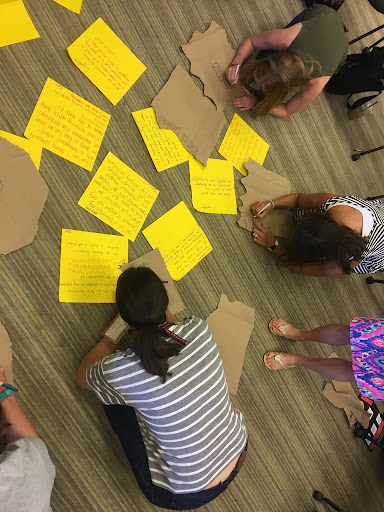Are you looking to create a meaningful experience that both acknowledges milestones and achievements AND provides a sense of closure?
I believe the secret lies in the design principle of UNITY.
Unity brings your design’s components together in harmony to convey a cohesive idea or experience.
For me, cohesion feels calm and together. Closure to a deep and sustained inquiry can bring a sense of accomplishment, pride, and togetherness. This leads me to wonder (and think like a designer):
How might the design principle of unity help me to facilitate a cohesive experience where participant/learner experiences are brought together in an open-ended way?
I found what I was looking for in the arts-ed activity called, Capangas.

What is a capanga?
“Capanga” is a Portuguese word referring to a small bag usually used by fishermen for fishing.
Developed by Brazilian educator, Daniel Soares, Capangas is inspired by a fisherman’s survival bag, filled with the tools he needs to fish and to sustain himself on long journeys away from home. Used as a metaphor for survival in life, Capagnas is an investigative, arts-based experience designed to be a bucket-filler.
Daniel explains, ‘When I thought of this activity, I thought about the fisherman and how he keeps the very important things in this bag that he needs for fishing, for sustaining himself, when he is at a river, far from the city. If we take the life of a teacher as the metaphor, then you would need a capanga always. And what do we keep in these capangas? We keep all the precious moments we live together as a community, so, when anything in life happens to make us want to give up, we can go back to our capangas to find what makes us strong and makes us want to keep going in life as a teacher.’
Source: The Arts Literacy Project, 2014
Where did I learn this activity?
Capangas served as the culminating activity for my week at Project Zero Classroom, at Harvard University. Thank you to my arts-based facilitators from Lesley University, Beth Delforge and Janet Ware, for sharing it with us. I loved every minute of it and believe my cohort members did too!
Here are the steps we took:
- Provide or invite each participant to create a capanga out of paper (we used a brown paper bag).
- Use coloured markers to record a short letter of appreciation on each participating member’s capanga: something that you might remember about your time together, a special attribute you appreciate, etc.
- Alternatively, you can use individual sheets of paper and put them into each person’s capanga OR make this a digital experience using a tool like Padlet or Jamboard.
